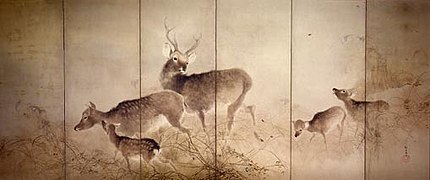Konoshima Ōkoku
Konoshima Ōkoku ( Japanese 木 島 桜 谷 , actually Konoshima Bunjirō (木 島 文 治郎), other artist names: Rōroujin (聾 盧 迂 人), Ryūchisōdō Shujin (龍池 草堂 主人); born March 6, 1877 in Kyoto ; died November 13, 1938 ) was a Japanese painter of the Nihonga direction during the Meiji , Taishō and early Shōwa periods .
life and work
Konoshima Ōoku was born the son of a businessman in Sanjō-Muromachi in the Nakaku district of Kyoto. He broke off his training at the Municipal School for Commerce and Commerce (京都 市立 商業 学校) and began studying painting under Imao Keinen in 1896 (今 尾 景 年; 1845–1924), at the same time studying poetry in the Chinese style (漢詩, Kanshi) under Yamamoto Keigu (山 本谿 愚; 1827–1903). In 1899 he showed at the exhibition of the Zenkoku Kaiga Kyōshinkai (全国 絵 画 共進 会) the picture "Uryū kyōdai" (瓜 生 兄弟), which won a prize and was bought by the Imperial Court Office.
Then Konoshima won at exhibitions of the Bijutsu Kyōkai (美術 協会), Naikoku Kangyō Hakurankai (内 国 勧 業 博 覧 会) and on other occasions awards. In 1907, at the first state exhibition, the Monbushō Tenrankai (文部省 美術展 覧 会), his picture "し ぐ れ" (Shigure, rain shower) was awarded a prize. He also received prizes at the following five “Bunten” exhibitions. In 1913 he was appointed a juror, and from the following year his pictures were automatically accepted. - In 1931 Konoshima was shown at the Japanese Painting Exhibition in Berlin.
Konoshima was in the tradition of the Maruyama Shijō school , which he continued with excellent craftsmanship. Together with Kikuchi Keigetsu , he was one of the painters who shaped the colorful exhibitions. He was a sensitive artist who is known for his animal and landscape pictures, as well as for his kachōga (花鳥画), i.e. pictures of flowers and birds. From the Taishō period he found his own personal style of representation, which also included socially critical elements. For the last time he exhibited on the 10th Teiten, namely the picture "峡 中 の 秋" (Kyōchū no aki, autumn valley). Then he devoted himself to the Chinese poems, the Kanshi. In 1938, Konoshima was hit by a train on the outskirts of Osaka and was killed.
photos
Remarks
- ↑ Left screen of a couple ( Kyōto National Museum of Modern Art ).
- ↑ This picture was shown in Berlin in 1931.
- ↑ a b Bunten is the abbreviation for the annual state art exhibition (文 展) for Mombushō bijutsu tenrankai ( 文部省 美術展 覧 会 ) from 1907 to 1918, Teiten ( 帝 展 ) is the abbreviation for follow-up facility (帝国美術展 覧 会 , Teikoku bijutsu- in tenrankai ) between 1919 and 1935.
literature
- National Museum of Modern Art, Kyoto (ed.): Konoshima Ōkoku. In: Kyōto no Nihonga 1910–1930. National Museum of Modern Art, Kyoto, 1986. ISBN 4-87642-117-X .
- Laurance P. Roberts: Konoshima Ōkoku . In: A Dictionary of Japanese Artists. Weatherhill, 1976. ISBN 0-8348-0113-2 .
Web links
| personal data | |
|---|---|
| SURNAME | Konoshima, Ōkoku |
| ALTERNATIVE NAMES | 木 島 桜 谷 (Japanese); Konoshima Bunjirō (real name); 木 島 文 治郎 (real name, Japanese) |
| BRIEF DESCRIPTION | Japanese painter |
| DATE OF BIRTH | March 6, 1877 |
| PLACE OF BIRTH | Kyoto |
| DATE OF DEATH | November 13, 1938 |





